
Sedimentary rocks are types of rock that are formed by the accumulation or deposition of mineral or organic particles at Earth's surface, followed by cementation. Sedimentation is the collective name for processes that cause these particles to settle in place. The particles that form a sedimentary rock are called sediment, and may be composed of geological detritus (minerals) or biological detritus. The geological detritus originated from weathering and erosion of existing rocks, or from the solidification of molten lava blobs erupted by volcanoes. The geological detritus is transported to the place of deposition by water, wind, ice or mass movement, which are called agents of denudation. Biological detritus was formed by bodies and parts of dead aquatic organisms, as well as their fecal mass, suspended in water and slowly piling up on the floor of water bodies. Sedimentation may also occur as dissolved minerals precipitate from water solution.
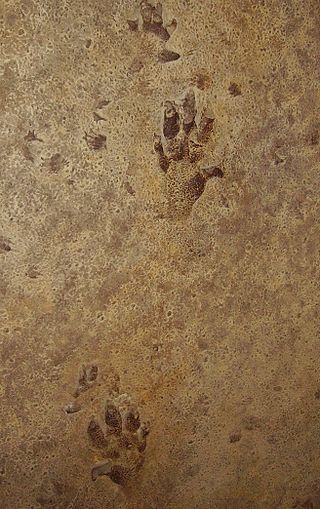
A trace fossil, also known as an ichnofossil, is a fossil record of biological activity but not the preserved remains of the plant or animal itself. Trace fossils contrast with body fossils, which are the fossilized remains of parts of organisms' bodies, usually altered by later chemical activity or mineralization. The study of such trace fossils is ichnology and is the work of ichnologists.
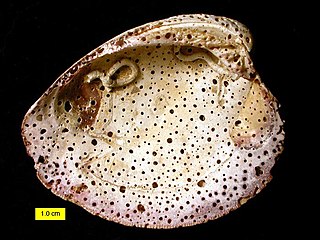
Bioerosion describes the breakdown of hard ocean substrates – and less often terrestrial substrates – by living organisms. Marine bioerosion can be caused by mollusks, polychaete worms, phoronids, sponges, crustaceans, echinoids, and fish; it can occur on coastlines, on coral reefs, and on ships; its mechanisms include biotic boring, drilling, rasping, and scraping. On dry land, bioerosion is typically performed by pioneer plants or plant-like organisms such as lichen, and mostly chemical or mechanical in nature.

Pholadidae, known as piddocks or angelwings, are a family of bivalve molluscs similar to a clam.
Trace fossils are classified in various ways for different purposes. Traces can be classified taxonomically, ethologically, and toponomically, that is, according to their relationship to the surrounding sedimentary layers. Except in the rare cases where the original maker of a trace fossil can be identified with confidence, phylogenetic classification of trace fossils is an unreasonable proposition.
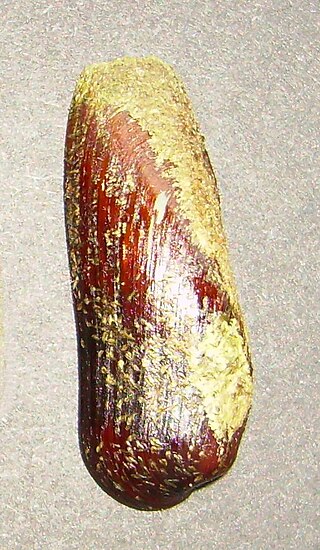
Lithophaga, the date mussels, are a genus of medium-sized marine bivalve molluscs in the family Mytilidae. Some of the earliest fossil Lithophaga shells have been found in Mesozoic rocks from the Alps and from Vancouver Island.

Marine sediment, or ocean sediment, or seafloor sediment, are deposits of insoluble particles that have accumulated on the seafloor. These particles have their origins in soil and rocks and have been transported from the land to the sea, mainly by rivers but also by dust carried by wind and by the flow of glaciers into the sea. Additional deposits come from marine organisms and chemical precipitation in seawater, as well as from underwater volcanoes and meteorite debris.

Carbonate hardgrounds are surfaces of synsedimentarily cemented carbonate layers that have been exposed on the seafloor. A hardground is essentially, then, a lithified seafloor. Ancient hardgrounds are found in limestone sequences and distinguished from later-lithified sediments by evidence of exposure to normal marine waters. This evidence can consist of encrusting marine organisms, borings of organisms produced through bioerosion, early marine calcite cements, or extensive surfaces mineralized by iron oxides or calcium phosphates. Modern hardgrounds are usually detected by sounding in shallow water or through remote sensing techniques like side-scan sonar.

Skolithos is a common trace fossil ichnogenus that is, or was originally, an approximately vertical cylindrical burrow. It is produced by a variety of organisms in shallow marine environments globally and appear as lineated features in sedimentary rocks.

Trypanites is a narrow, cylindrical, unbranched boring which is one of the most common trace fossils in hard substrates such as rocks, carbonate hardgrounds and shells. It appears first in the Lower Cambrian, was very prominent in the Ordovician Bioerosion Revolution, and is still commonly formed today. Trypanites is almost always found in calcareous substrates, most likely because the excavating organism used an acid or other chemical agent to dissolve the calcium carbonate. Trypanites is common in the Ordovician and Silurian hardgrounds of Baltica.

Ophiomorpha is an ichnotaxon, usually interpreted as a burrow of an organism living in the near-shore environment. The burrow lining is more or less smooth on the inside, and densely to strongly mammalated or nodose on the outside, due to the packing of fecal pellets for support of the burrow. Branching is irregular but Y-shaped where present. It is often considered part of the Skolithos ichnofacies, where it has occurred since the early Permian, though it has also occurred in deep water settings since the Late Jurassic, such as well-oxygenated turbidites.

The Acrothoracica are an infraclass of barnacles.
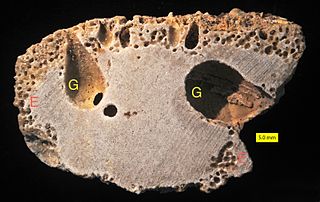
Gastrochaenolites is a trace fossil formed as a clavate (club-shaped) boring in a hard substrate such as a shell, rock or carbonate hardground. The aperture of the boring is narrower than the main chamber and may be circular, oval, or dumb-bell shaped. Gastrochaenolites is most commonly attributed to bioeroding bivalves such as Lithophaga and Gastrochaena. The fossil ranges from the Ordovician to the Recent. The first Lower Jurassic Gastrochaenolites ichnospecies is Gastrochaenolites messisbugi Bassi, Posenato, Nebelsick, 2017. This is the first record of boreholes and their producers in one of the larger bivalves of the globally occurring Lithiotis fauna which is a unique facies in the Lower Jurassic Tethys and Panthalassa.
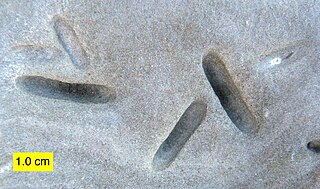
Petroxestes is a shallow, elongate boring originally found excavated in carbonate skeletons and hardgrounds of the Upper Ordovician of North America. These Ordovician borings were likely made by the mytilacean bivalve Corallidomus as it ground a shallow groove in the substrate to maintain its feeding position. They are thus the earliest known bivalve borings. Petroxestes was later described from the Lower Silurian of Anticosti Island (Canada) by Tapanila and Copper (2002) and the Miocene of the Caribbean by Pickerill et al. (2001).

Entobia is a trace fossil in a hard substrate formed by sponges as a branching network of galleries, often with regular enlargements termed chambers. Apertural canals connect the outer surface of the substrate to the chambers and galleries so the sponge can channel water through its tissues for filter feeding. The fossil ranges from the Devonian to the Recent.
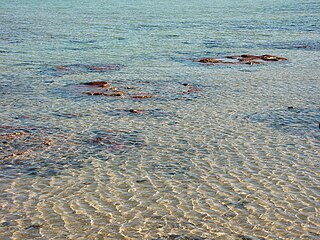
Shallow water marine environment refers to the area between the shore and deeper water, such as a reef wall or a shelf break. This environment is characterized by oceanic, geological and biological conditions, as described below. The water in this environment is shallow and clear, allowing the formation of different sedimentary structures, carbonate rocks, coral reefs, and allowing certain organisms to survive and become fossils.
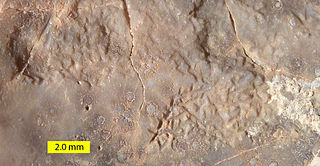
Gnathichnus is a trace fossil on a hard substrate formed by regular echinoids as they scraped the surface with their five-toothed Aristotle's Lantern feeding structures.
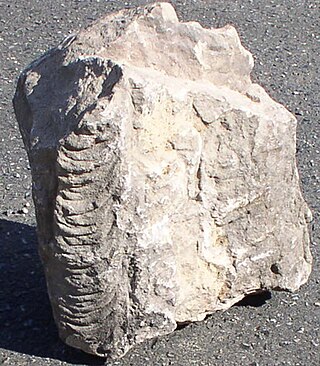
Spreite, meaning leaf-blade in German is a stacked, curved, layered structure that is characteristic of certain trace fossils. They are formed by invertebrate organisms tunneling back and forth through sediment in search of food. The organism moves perpendicularly just enough at the start of each back-and-forth pass so that it avoids reworking a previously tunneled area, thereby ensuring that it only makes feeding passes through fresh, unworked sediment.

Burrow fossils are the remains of burrows - holes or tunnels excavated into the ground or seafloor - by animals to create a space suitable for habitation, temporary refuge, or as a byproduct of locomotion preserved in the rock record. Because burrow fossils represent the preserved byproducts of behavior rather than physical remains, they are considered a kind of trace fossil. One common kind of burrow fossil is known as Skolithos, and the similar Trypanites, Ophiomorpha and Diplocraterion.

Solecurtus strigilatus, also known as the rosy razor clam, is a species of saltwater clam, a marine bivalve mollusc in the family Solecurtidae. This mollusc is a suspension feeder and can burrow with great rapidity to escape predators. It is an unusual bivalve in that its shell valves are too small to contain all the soft tissue, and the animal is unable to retreat into its shell.




















